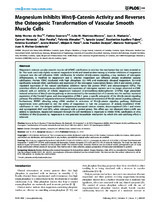Magnesium Inhibits Wnt/β-Catenin Activity and Reverses the Osteogenic Transformation of Vascular Smooth Muscle Cells
Autor
Montes de Oca, Addy
Guerrero Pavón, Fátima
Martínez-Moreno, Julio M.
Madueño, Juan A.
Herencia, Carmen
Peralta, Alan
Almadén Peña, Yolanda
López, Ignacio
Aguilera Tejero, Escolástico
Gundlach, Kristina
Büchel, Janine
Peter, Mirjam E.
Passlick-Deetjen, Jutta
Rodríguez Portillo, Mariano
Muñoz-Castañeda, Juan R.
Editor
Public Library of ScienceFecha
2014Materia
MagnesiumCalcification
Phosphates
Gene expression
Small interfering RNAs
Signal inhibition
Wnt signaling cascade
Vascular smooth muscle cell
METS:
Mostrar el registro METSPREMIS:
Mostrar el registro PREMISMetadatos
Mostrar el registro completo del ítemResumen
Magnesium reduces vascular smooth muscle cell (VSMC) calcification in vitro but the mechanism has not been revealed so far. This work used only slightly increased magnesium levels and aimed at determining: a) whether inhibition of magnesium transport into the cell influences VSMC calcification, b) whether Wnt/β-catenin signaling, a key mediator of osteogenic differentiation, is modified by magnesium and c) whether magnesium can influence already established vascular calcification. Human VSMC incubated with high phosphate (3.3 mM) and moderately elevated magnesium (1.4 mM) significantly reduced VSMC calcification and expression of the osteogenic transcription factors Cbfa-1 and osterix, and up-regulated expression of the natural calcification inhibitors matrix Gla protein (MGP) and osteoprotegerin (OPG). The protective effects of magnesium on calcification and expression of osteogenic markers were no longer observed in VSMC cultured with an inhibitor of cellular magnesium transport (2-aminoethoxy-diphenylborate [2-APB]). High phosphate induced activation of Wnt/β-catenin pathway as demonstrated by the translocation of β-catenin into the nucleus, increased expression of the frizzled-3 gene, and downregulation of Dkk-1 gene, a specific antagonist of the Wnt/β-catenin signaling pathway. The addition of magnesium however inhibited phosphate-induced activation of Wnt/β-catenin signaling pathway. Furthermore, TRPM7 silencing using siRNA resulted in activation of Wnt/β-catenin signaling pathway. Additional experiments were performed to test the ability of magnesium to halt the progression of already established VSMC calcification in vitro. The delayed addition of magnesium decreased calcium content, down-regulated Cbfa-1 and osterix and up-regulated MGP and OPG, when compared with a control group. This effect was not observed when 2-APB was added. In conclusion, magnesium transport through the cell membrane is important to inhibit VSMC calcification in vitro. Inhibition of Wnt/β-catenin by magnesium is one potential intracellular mechanism by which this anti-calcifying effect is achieved.

